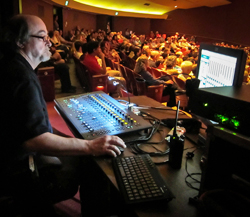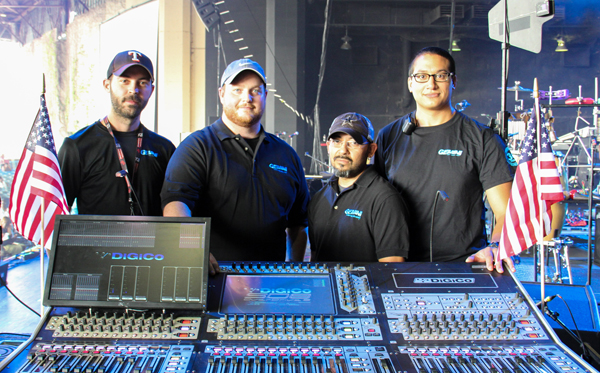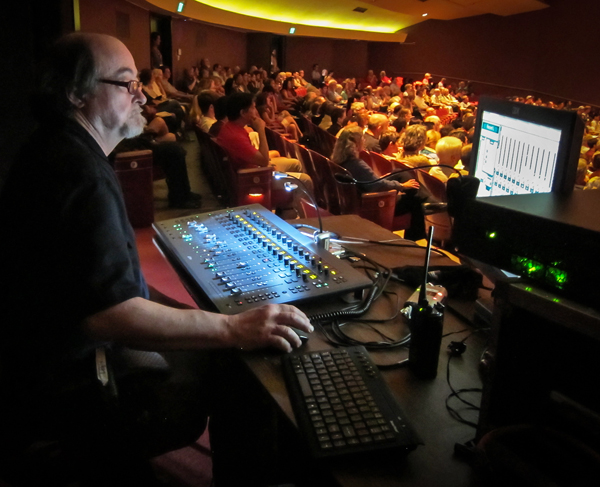
Frankie Beverly & Maze On Tour
Gemini Light Sound & Video (Dallas) recently added its first DiGiCo console, an SD8 accompanied by an SDRack.
Both were immediately pressed into service by monitor engineer Dustin Rains for R&B legend Frankie Beverly & Maze on a 6-week U.S. tour.
“We were in the middle of prepping the Frankie tour, and I was already committed to using another desk,” Rains says. “The first thing I liked about the SD8 was that the level of customization available was incredible. I could have anything where I wanted it and that was exactly what I was looking for.
“Some fader banks have input faders, output faders, and control groups—all on one fader bank—which has cut down on how many times I have to bump between layers and pages,” he continues. “I have a few fader banks set up for cue-intensive songs, which allow me to execute multiple cues quickly without leaving the fader bank, going to another layer, or switching screens.
“Also, I use most of the DiGiTuBe and dynamic EQs for added control of overly dynamic channels. In fact I use most everything onboard, and it’s a fairly straightforward approach.”
An all-d&b audiotechnik stage monitor set is deployed for Beverley’s 7-piece band, including 20 M4 wedges, three Q-subs in a cardioid pattern topped with two Q-7s for side fills, and two Q-Subs for drum fill. “In my opinion, DiGiCo and d&b make the job really easy,” Rains adds.
Pictured left to right in the photo are audio crew members Trae Sales, Dustin Rains, Jason Delatorre, and Jimmy Butera.
Stanford Jazz Festival/Workshop
The Stanford Jazz Workshop has been nurturing talent for over 40 years, bringing in some of the world’s greatest artists to mingle with students of the Jazz Camp by day, followed by performances at the Stanford Jazz Festival by night.
Most of this year’s performances were held in Stanford’s Dinkelspiel Auditorium, with Bay Area live sound veteran Lee Brenkman, who’s been associated with the festival for more than a decade, again taking on sound reinforcement responsibilities.
Brenkman chose the new Avid S3L for this year’s festival, with the modular, networked system enabling a simplified setup while insuring sound quality. He strategically used the layers of the S3L’s compact surface to handle a variety of mixing tasks.
“I mix the for the house, I mix the monitors, and I’m doing a completely separate mix for the recording, because at Dinkelspiel [Auditorium], for example, the amount of trap drums I need on the recording is much more than what I need in the auditorium,” Brenkman explains. “So what I did is assign all the head amps to two layers. The top layer of 16 [channels] was for the PA, and then I could switch to [channels] 17–32, and those were my recording mix. On average, I was doing four monitor mixes, and in some cases, six. I did not feel at any time that the console was too complicated to grab at something fast.
“All of the festival techs were really fascinated with the system, really liking the size, the Cat-5 snake—the things that make setting up and tearing down a system a drag,” he says. “We ran a couple of runs of Cat-5 and were able to keep the snake in place, just striking the stage boxes at the end of the night to get them out of the way of the classroom kids.
“Just changing out our usual console for this was an enormous improvement in sound quality—it was really audible. Everybody agreed that it just sounded noticeably better.”
Saxon On Tour
Mix engineer Ben Hammond is traveling with Allen & Heath GLD and iLive digital consoles for both monitors and front of house on the U.S./Canada tour by iconic English heavy metal band Saxon, with American band Fozzy also on the bill.
The iLive system at monitors includes an iLive-T112 surface and iDR-48 MixRack that routes its direct outs, via Audinate Dante networking, to the GLD channel inputs. Hammond is then sending talkback and a split of the iPod channels for the intro back down Dante to the iLive surface, which gets piped into the bands’ IEMs. Dante controller software is also routing the audio into Reaper for multitrack recording via the Dante virtual sound card.
“I’m currently running a 39-input ‘festival patch’ type channel list to fit both Saxon and Fozzy, and GLD has coped fantastically,” explains Hammond. “I’m using all eight on board FX engines, which sound stunning—the EMT250 and ADT presets are personal favorites of mine.
“As well as the FX, so many great iLive features have been included in GLD, one of which that I find incredibly useful is the filter on the compressor section,” he adds. “I’m using it for Saxon’s frontman, Biff Byford, to hit his vocal pretty hard from 800 Hz to 4 kHz, which keeps his voice sounding thick and full right into the higher registers. I’m putting the vocals into a subgroup where I apply full band compression with the Manual Peak setting.
“The GLD Editor has been great on this tour especially for programming shows for the various press and TV appearances where we have taken the GLD, and run a much more cut down channel list, with me doing the IEMs also, and mixing L+R for the TV feed,” he concludes.



